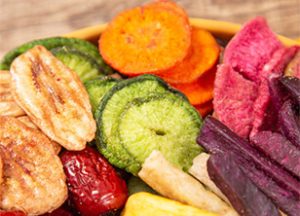

Pearl powder balls screening needs screening purpose : size grading use equipment: Rotary vibrating screen/Linear vibrating screen Screening mesh: 4-10mm Screening capacity: 500-2000kg/hour Information Pearl…

The main raw materials of taro balls: they are made from a mixture of taro, sweet potato, purple sweet potato, cassava flour and other materials.

The main raw materials of explosive beads : sodium alginate, calcium lactate and fruit pulp

Main raw materials of gummies: gelatin, maltose syrup, concentrated fruit juice, etc.

The wood flour thickness is great difference after crushing , in order to meet the needs of production and preparation, through the vibrating screen, the thickness of the mixed powder separation of coarse powder and fine powder.

Ceramic powder introduction
The so-called ceramic powder is a powdery substance in which all the raw materials are uniformly mixed and then calcined (also called calcination, pre-synthesis) when preparing the ceramic. The chemical reaction between the raw materials of the ceramic is not carried out in a molten state, but it is achieved by diffusion between atoms (or ions) at a temperature lower than the melting point, that is, a solid phase reaction, so The ceramic powder obtained by calcination (pre-synthesis) is already a pure phase crystalline material.

Ceramic process
First, kaolin, ceramic powder and other raw materials are ground by a ball mill according to the proportion of ceramic formula, and then sieved through the first vibrating screen. At this time, the mesh number is about 30-50 mesh. The sieved raw material enters the slurry tank, and then the water is thoroughly mixed by the mixer, and the discharged slurry is sieved through second vibrating sieve. At this time, the mesh number is between 80 and 325 mesh. The number of meshes depends on the requirements of the product. The resulting slurry is then placed in a ceramic kiln for drying into ceramic granules, which are then formed by a press and then calcined into a kiln. After polishing, uranium is required for uranium bricks. Uranium is filtered by a vibrating filter during uranium application.

Abrasive introduction
Abrasives are sharp, hard materials that grind softer material surfaces. Abrasives with natural abrasive and artificial abrasive two broad categories. According to the hardness of the super-hard abrasive and general extra-abrasive two categories. Abrasives range from softer household detergents, gem abrasives to the hardest material diamonds. Abrasive materials are indispensable for the manufacture of every precision product. Many natural abrasives have been replaced by artificial abrasives. In addition to diamonds, natural abrasive properties are not stable, but still its use value. Diamond is the hardest abrasive, origin South Africa, accounting for 95% of the world’s total output, the rest of Brazil, Australia, Guyana and Venezuela and other places. Industrial diamond from white to black ranging from crushed grinding wheel, belt, polishing wheel and grinding powder.

Dehydrated vegetables: also known as cabbage, is a kind of dried vegetable which is made of fresh vegetables after washing, drying and so on. After removing most of the water in vegetables, the original color and nutrition of vegetables are basically kept unchanged. It is easy to store and transport, and can effectively regulate the vegetable production in the light season. When eaten, it is soaked in clean water. It can recover and preserve the original color, nutrition and flavor of the vegetables.